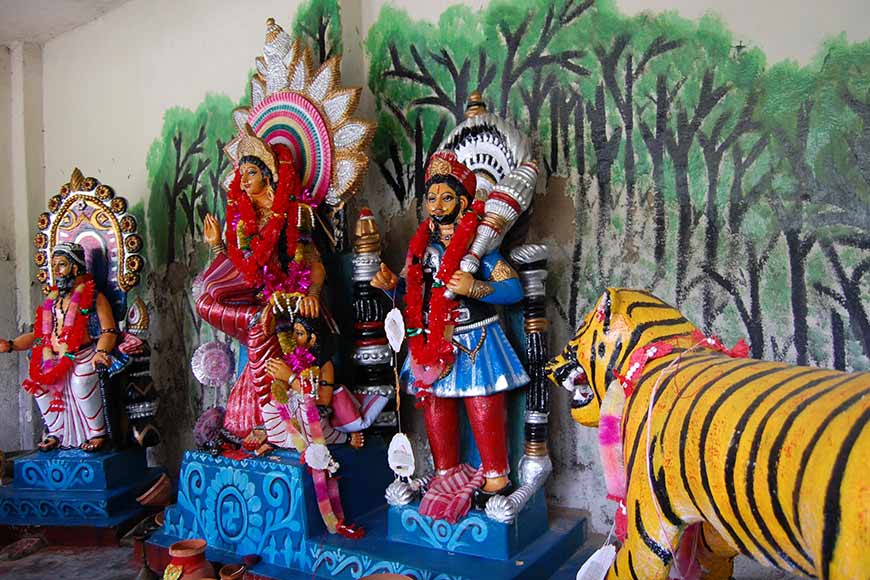As Sundarbans lies ravaged post Cyclone Amphan, GB traces history of this land

Sunanda Bose is an activist and member of Taki Zamindar Family. She is also a great story-teller and reminisces her childhood tales of Sundarbans
Fearsome, tantalizing, dangerous... yet beautiful Sundarbans. A land of Prey and Predator, Habitat of the world famous Royal Bengal Tiger. Since childhood, I had heard that Taki, the homeland of my forefathers was the Gateway to the Sundarbans and that the Zamindaries of Taki families, were located in the Sundarbans. As children, the annual winter visits to the Zamindary Mahals or ABAAD was something we looked forward to. First the journey by car or by the tiny toy like Martin Railway to Hasnabad, and then the travel by boat to Abad via Ichhamati.
The dates of boat journeys were always chosen after consulting timings of High Tide and Low Tide as per the Almanac. Kotals and Mara Kotals were very important. Practically all zamindars owned Bajras. My father although a petty zamindar compared to many, also owned a small House-Boat. It was an eight Malla Boat with four Mallas or boat men rowing in front and four rowing at the rear. The boat was steered by a wooden hull fixed at the rear end. The Mallas were Beldars or men who were in my father’s service and did other jobs when they were not rowing. There were at least two to three guns aboard the boat for the sake of safety. Two Rayats of my father Rajen Patra and Zafar Ali and a Beldar called Neelkanto were crack shots and would always accompany us. Our favourite trip was to the Kachhari Bari of Baro Tushkhali in Sandeshkhali Mouza situated nearer to the Sundarbans. It was a long journey from our first halt The Kachari of Chak Patli. Now of course if one follows Basanti Highway to Dhamakhali, on Vidya River, Borotuskhali is just around the corner, by motor-boat.
My first acquaintance with Sundarbans was through stories, I heard from Zafar Ali and Neelkanto during the boat ride. They were residents of Boro Tushkhali. The names of the places changed dramatically into endings with “Khalis” from “Berias” and “Talis.” Zafar chacha explained this was because of the innumerable creeks or Khals, criss-crossing the dense mangrove forests of Sundarbans. The scenario changed. The river became wider. The Bheries or embankments on both sides were not bare. They were covered with shrubs which Zafar chacha explained were mostly Babla trees, interspersed with some mangrove species like Byne and Keora. The river-banks were full of common white storks or Baks waiting patiently to catch fish. Sometimes on a high tree we would spot a pair of Grey Storks locally known as Kanks. At once the boat would slow down and veer as near to the bank as possible and guns would be aimed. It was however difficult to get one as the birds would spread their wings and take flight. The easiest prey were the brown coloured Snipes, both large sized and of the smaller variety. They were locally called Batam Pakhi and the smaller ones Baters. They would sit on the edge of the river-bank and their colonies would be noticed from afar in a brown patch. The boat would slow down and guns would be fired.
At least twenty to thirty birds would immediately fall into the river. The Mallas would jump immediately into the water and gather as many birds as they could. Incidentally, only two or three were actually hit, the rest were all shocked and could not move. We as children would wait for Snipe roast. Cormorants or black Pan Kowries were found diving into the water for fish and then shaking off water from the body after reaching the banks. We spared the white storks and cormorants as from past experience we knew that they were not tasty enough. Lots of migratory birds, including Himalayan Geese would be found on the Chars or sand strips in the middle of the river. At times the Red Ducks or Chakha Chakhis could be seen sitting in solitary pairs. They were always coveted prizes but hardly if ever success was met with. It was much later in life that I realised how in our greed we were destroying the precious ecology, fauna and bio-diversity of Sundarbans. Years later, when I revisited the area the birds had all disappeared and the river banks were barren. Only when one visited the core area of Sundarbans, the birds could be seen but in far lesser numbers.
Apart from birds, often a fountain of water would rise from the river and we ran to see the Ganges Dolphins or Shushuks. They were quite a common sight. Sometimes crocodiles would be basking in the sun on the Chars and river banks. The Gharials with long pointed snouts locally known as Mecho Kumir were also there in plenty. Often we would see children and adults standing in knee deep water catching shrimps and prawn seeds for fisheries. Zafar chacha explained that their life was in danger. Deep in the river there was a species of Shark like creatures called Kamats. With their sharp saw-like teeth they would cleanly cut away the victims submerged limbs or body parts without the victim even being aware of it. Their secretiong had an anaesthetic agent. Apart from the Tiger, the crocodiles and snakes, Kamats are one of the worst predators of Sundarbans. Each year several people including children are killed or maimed due to attack of Kamats underwater. Alas! When I went back there much later I found that except the Kamats all other creatures had practically vanished from the rivers. Only once did I see the Ganges Dolphin in the core area in 2011.
Sometimes we would see from afar a square low-lying platform with red awning sailing in our opposite direction with someone lying on it. As it approached nearer we realised that the platform was a raft or Vela made by tying the stems of Banana tree. The body lying on it was the dead body of a person who had died of snake bite and was set to sail by his relatives as per the legend of Behula and Lakhinder. We felt an unknown thrill in realising that this was the route followed by Behula nearly thousand years ago with the dead body of her husband Lakhinder, son of Chand Saudagar. My mentors told me that far off inside the dense forest of Sundarbans near Neti Dhopanis Ghat there lay the ruins of more than thousand-year-old city. No man had ever set a foot there, except the king of the Sundarban forests Raja Dakshin Rai. During daytime he patrolled his kingdom on a white steed and at night he took the form of a Tiger. The ruins were probably that of a city built by Chand Saudagar who had sailed to the Lands of Atharo Bhati or Eighteen Tides. We learnt the names of mighty tributaries of the Ichhamati, which crisscrossed through the Sundarbans giving rise to innumerable islands. They were Matla, Raimangal, Kalindi, Vidya, Hogol and several others. All were tidal rivers and every year created havoc to villages. Remember the devasting Aila of 2009? It wiped out villages after villages and made the once fertile land useless for cultivation by inducting saline water content of farmlands. Had not men destroyed, the ecology of the area, by cutting and destroying mangrove forest, the river embankments would not have been breached so easily.









